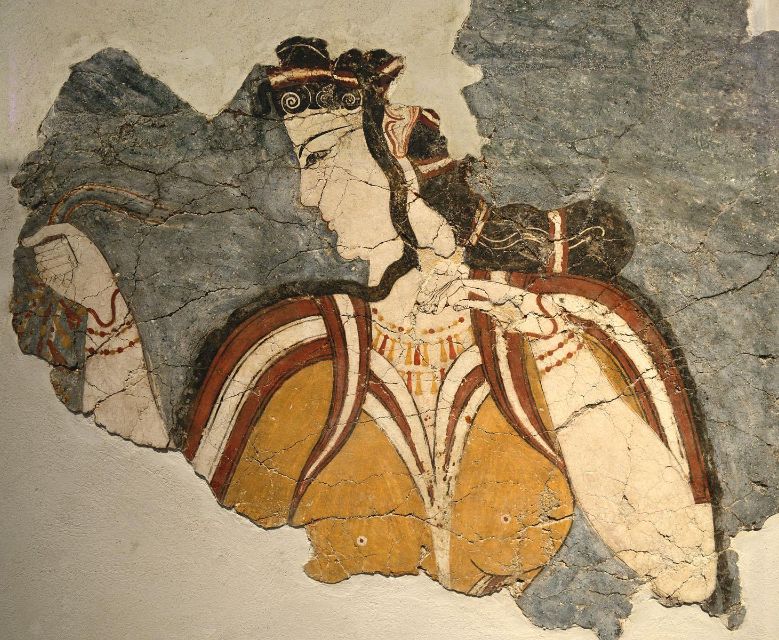Late Bronze Age Art & Female Figures in Frescoes: A Comparison of Palatial Centers
- Minoan Ladies in Blue
There were more palatial centers with frescoes in the Mycenaean period (ca. 1750 – 1050 BC) that followed the Minoan period. A few of these frescoes are shown below. The next few paragraphs will discuss these four frescoes and their artistic similarities, providing a comparison to show how the palaces drew inspiration from each other and were connected over a longer span of time.
The Mycenaean palaces (like the ones in Mycenae, Tiryns and Pylos) were almost identical to the Minoan palace at Knossos, with similar rooms for agricultural and economic storage and religious ceremonies that displayed frescoes on their walls. The depictions ranged from bulls, birds and flowers, to warriors, and women. The frescoes at the Palace of Knossos were the inspiration for all of them.
Just as the ‘Ladies in Blue’ fresco is largely a restoration, so are these frescoes. Their restorations also depend on each other, since the restorers make use of earlier restorations. Examples of similarities are the ‘Lady in Red’ (Fig. 6) from Knossos Palace, dated to early Late Minoan IA period (LM IA - ca. 1600/1570 BC); the ‘Two Seated Women’ (Fig. 7) from Pseira (Crete), and the ‘Goddess’ fresco (Fig. 8) from Ayia Triada (Crete), both of which are dated to Late Minoan IB (LM IB - ca. 1490/1470 BC); and the ‘Mykenaia’ (Mycenaean Woman) (Fig. 9), dated to Late Helladic IIIB2 (LH IIIB2 - ca. 1300/1200 BC).
In these four related frescoes, the women wear similar attire to the ‘Ladies in Blue’: open jackets with trim, textile patterns, torsos facing forward, smile and nostril lines, visible nipples, and faces turned to the side. Their hair is in an updo with curls coming down the side of their faces.
At first glance, the women in the ‘Ladies in Blue’ fresco seem to be lacking visible nipples, but in the original fragment of the woman on the far right, the outline of a nipple is visible. The lack of visible nipples on the other women in this fresco seems to be a choice of the restorer, and not a reflection of the original artist, since nipples are visible in the other frescoes depicting females.
Notable differences between the ‘Ladies in Blue’ fresco and these other frescoes are the skirts (or kilts) over the dresses, and their positioning in the photo (standing or seated). This is the case with the woman in the ‘Goddess’ fresco (Fig. 8), in which she appears to be dancing. Since there is no bottom portion to the ‘Ladies in Blue’ fresco, we are unable to determine if these women also wore skirts, or if they are standing or seated.
Overall, there is a continuation of style, fashion, posture and portrayal of women from the sixteenth century BC (‘Lady in Red’) until the ‘Mykenaia’ fresco (ca. 1300-1200 BC), all around the Greek world from Crete to the mainland.
, _Archaeology_ 24 (1): 42).](https://micrio.thingsthattalk.net/pDrOS/views/max/640x640.jpg)
Fig. 6. 'Lady in Red' reconstruction by Gilliéron. (Cameron, M.A.S. (1971). "The Lady in Red: A Complementary Figure to the Ladies in Blue.", Archaeology 24 (1): 42).
, _British School at Athens Studies_ 13:29.)](https://micrio.thingsthattalk.net/UmlQG/views/max/643x640.s.jpg)
Fig. 7. Reconstruction of the relief fresco from Pseira by Maria Shaw and G. Bianco. (Morgan, L. (2005). "New Discoveries and New Ideas in Aegean Wall Painting.", British School at Athens Studies 13:29.)
, _British School at Athens Studies_ 13: 27).](https://micrio.thingsthattalk.net/ARxdr/views/max/954x640.s.png)
Fig. 8. Reconstruction of the Goddess from the east wall of Room 14. ( Morgan, L. (2005). "New Discoveries and New Ideas in Aegean Wall Painting.", British School at Athens Studies 13: 27).

Fig. 9. New reconstructions of the “Mykenaia”. (Jones, B.R. (2009). ["New Reconstructions of the 'Mykenaia' and a Seated Woman from Mycenae."[(www.jstor.org/stable/20627591) American Journal of Archaeology 113 (3): 334).